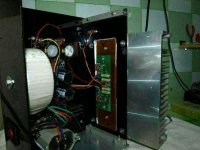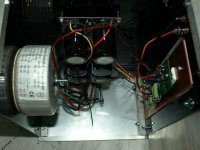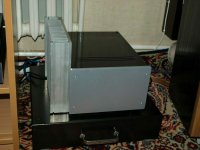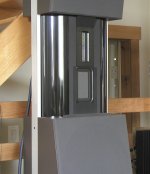In about 10 years time, surely
And by then you may begin to experience troubles sourcing parts fore SS amps
NOS devices at prices far worse than now
LOL... Nah , by then we will have SS nut jobs, just like the tube guys , sourcing and remanu 70's type transistors for that vintage sound ... 😀
Yep , flying cars, digital moon trips and Vintage Hi-Fi ...Analog/tube front end, with Aleph F599 ..... Stardate 2090...
Sorry Class D...uh ... still have a longggg way to go , well for me anyway ...
.,
Last edited:
I run 'normal' speakers - 85dB/W is a 400sq.ft room. The gain of the F5 is reasonable enough for recordings that hit the top of the clip meters and don't dip too low - so most modern pop and rock is fine. With a lot of old Classical recordings, and a lot of Indian recordings as well, there is a big problem because the average recording level is too low so the amp can't dig out micro-detail, and swinging full output becomes an issue.
Assuming the same 20Vp-p voltage swing of some of the other amps in the F series, the F5 would need 6dB additional gain from a 2V p-p output like a CD player or most -10dBV equipment like soundcards. Plus some additional gain for those tricky low-level recordings, so assume about 12-15dB from a preamp. That should be sufficient for maximum output (which, btw, is not really that small) irrespective of source and speakers. In stock form, the amp probably likes 90dB+ sensitivity speakers, more if possible.
I don't use any device (not even a capacitor) between the I/V stage of my DAC and the F5, and like the fact that I run run flat out with zero bit resolution loss (no attenuation) and not risk damage to my hearing or my speakers. I don't listen to classical at all, so the gain is OK for me, all things considered. Anyway this is a winter amp, it does not have to fight the ceiling fan and the hum of a hundred airconditioners in summer.
Assuming the same 20Vp-p voltage swing of some of the other amps in the F series, the F5 would need 6dB additional gain from a 2V p-p output like a CD player or most -10dBV equipment like soundcards. Plus some additional gain for those tricky low-level recordings, so assume about 12-15dB from a preamp. That should be sufficient for maximum output (which, btw, is not really that small) irrespective of source and speakers. In stock form, the amp probably likes 90dB+ sensitivity speakers, more if possible.
I don't use any device (not even a capacitor) between the I/V stage of my DAC and the F5, and like the fact that I run run flat out with zero bit resolution loss (no attenuation) and not risk damage to my hearing or my speakers. I don't listen to classical at all, so the gain is OK for me, all things considered. Anyway this is a winter amp, it does not have to fight the ceiling fan and the hum of a hundred airconditioners in summer.
sangram, put a scope on the output of the F5, if ur running at say 92dBSPL at your listening position average, almost certainly you are clipping on peaks... but don't worry, most people don't know that they are clipping on peaks anyhow...
🙂
_-_-bear
🙂
_-_-bear
Choke loaded F5 ???
Hi guys I just make my first ever DIY SS amps.
It's mono F5 with BUZ900?BUZ905 transistors.
PS is CLC with UTC 2 X 30mH/2.5A/0.6R choke.
Amps run at +/- 24VDC with offset and noise under 1mV.
After all day playing at 1.4A current on each BUZ I get
42*C on radiator.Not bad I hope.
Now I like to ask Dear N.Pass here and all other person who
made this amps.
I feel that this choke in PS is waste .
How obout to use this choke as load resistors on BUZ
transistors ? I have a 0.5R Mills for now.
Thanks for any help and idea.
This is the best amps I have in home exepts big 211 on board
long time ago.
I know how to wire the staff but not much more :>)
I hope that this question is not so stupid .
But better ask ...... them burn anything.
Amps are not finished I wait for Sikorels and this is amp without
termistors and current limiting section
Hi guys I just make my first ever DIY SS amps.
It's mono F5 with BUZ900?BUZ905 transistors.
PS is CLC with UTC 2 X 30mH/2.5A/0.6R choke.
Amps run at +/- 24VDC with offset and noise under 1mV.
After all day playing at 1.4A current on each BUZ I get
42*C on radiator.Not bad I hope.
Now I like to ask Dear N.Pass here and all other person who
made this amps.
I feel that this choke in PS is waste .
How obout to use this choke as load resistors on BUZ
transistors ? I have a 0.5R Mills for now.
Thanks for any help and idea.
This is the best amps I have in home exepts big 211 on board
long time ago.
I know how to wire the staff but not much more :>)
I hope that this question is not so stupid .
But better ask ...... them burn anything.
Amps are not finished I wait for Sikorels and this is amp without
termistors and current limiting section
Attachments
Hi guys I just make my first ever DIY SS amps.
It's mono F5 with BUZ900?BUZ905 transistors.
PS is CLC with UTC 2 X 30mH/2.5A/0.6R choke.
Amps run at +/- 24VDC with offset and noise under 1mV.
After all day playing at 1.4A current on each BUZ I get
42*C on radiator.Not bad I hope.
Now I like to ask Dear N.Pass here and all other person who
made this amps.
I feel that this choke in PS is waste .
How obout to use this choke as load resistors on BUZ
transistors ? I have a 0.5R Mills for now.
Thanks for any help and idea.
This is the best amps I have in home exepts big 211 on board
long time ago.
I know how to wire the staff but not much more :>)
I hope that this question is not so stupid .
But better ask ...... them burn anything.
Amps are not finished I wait for Sikorels and this is amp without
termistors and current limiting section
if you're talking about resistors between output mosfets and rails - don't even think about that .
in F5 - each output mosfet is load to adjacent one . source resistors are there for other reasons , not as load
I run 'normal' speakers - 85dB/W is a 400sq.ft room. The gain of the F5 is reasonable enough for recordings that hit the top of the clip meters and don't dip too low - so most modern pop and rock is fine. With a lot of old Classical recordings, and a lot of Indian recordings as well, there is a big problem because the average recording level is too low so the amp can't dig out micro-detail, and swinging full output becomes an issue.
Assuming the same 20Vp-p voltage swing of some of the other amps in the F series, the F5 would need 6dB additional gain from a 2V p-p output like a CD player or most -10dBV equipment like soundcards. Plus some additional gain for those tricky low-level recordings, so assume about 12-15dB from a preamp. That should be sufficient for maximum output (which, btw, is not really that small) irrespective of source and speakers. In stock form, the amp probably likes 90dB+ sensitivity speakers, more if possible.
I don't use any device (not even a capacitor) between the I/V stage of my DAC and the F5, and like the fact that I run run flat out with zero bit resolution loss (no attenuation) and not risk damage to my hearing or my speakers. I don't listen to classical at all, so the gain is OK for me, all things considered. Anyway this is a winter amp, it does not have to fight the ceiling fan and the hum of a hundred air conditioners in summer.
Sangram ,
Thanks for the response , since i plan to use a pre-amp , gain should not be a problem to drive to full power , but it would be nice to get some extra gain and what it would take to do so . Did you ever measure the output power ?
sangram, put a scope on the output of the F5, if ur running at say 92dBSPL at your listening position average, almost certainly you are clipping on peaks... but don't worry, most people don't know that they are clipping on peaks anyhow...
🙂
_-_-bear
That's why i had opted for the bigger output stage Version F5 and toying with doing a bridged version which has also been mentioned . Has anyone done one yet , what about balanced ?
if you're talking about resistors between output mosfets and rails - don't even think about that .
in F5 - each output mosfet is load to adjacent one . source resistors are there for other reasons , not as load
Well looks like I have to learn a lot :>) Thanks !!!
Super V with F5 or F3
I'm a little apprehensive of which, F3 or F5 to get. Both would work with the Super V. So far I've purchased the boards for the F5. I might build both in the same cabinet. Since I plan mono-blocks. I wonder if anyone has tried this.
Ray
Ray
please keep us informed, I am interested in doing an identical system. super v's and f5's.(I am an audiphile and diy virgin....i will be hangining on your every word). What type of heat sinks/enclosures(very important here in San Antonio, TX) will you be using? Where are you getting your components? I definatley want to use high quality....if you don't mind me asking, how much do you estimate your amp build to cost?
thanks
thanks
Shane
I'm a little apprehensive of which, F3 or F5 to get. Both would work with the Super V. So far I've purchased the boards for the F5. I might build both in the same cabinet. Since I plan mono-blocks. I wonder if anyone has tried this.
Ray
I'm a little apprehensive of which, F3 or F5 to get. Both would work with the Super V. So far I've purchased the boards for the F5. I might build both in the same cabinet. Since I plan mono-blocks. I wonder if anyone has tried this.
Ray
That is a simple? yet ingenious idea,imo. I would think that someone would have attempted this but perhaps not. Examining the original design I did notice how the circuitry is arranged and isolated/spaced, probably not by accident. the arrangement and placement of the electronics may play a role into the interferance and feedback performance of the amp. 😕 I am not an electrical engineer and have no knowlege of these things, but I have to believe the arrangement is purposeful right down to the long thin circuit boards(see link).
6moons audio reviews: FirstWatt F5
Shane
ps. Ray, Have you begun assembly of the amp, or the speakers?
Just an update:
I did some listening to my F5’s on a Variac and reduced the Voltage to +-25V. The sound lost the extra bloom I was hearing with the rails at 33 volts, a definite improvement. So I took Nelsons advice and cascoded the input FET’s setting the drain voltage to 20V. The sound was like running at 25V but with the 33volt rails for the outputs. I don’t know why I was hesitant to try the cascode mod but it is defiantly worth it if you are running with a higher voltage supply.
🙂
I did some listening to my F5’s on a Variac and reduced the Voltage to +-25V. The sound lost the extra bloom I was hearing with the rails at 33 volts, a definite improvement. So I took Nelsons advice and cascoded the input FET’s setting the drain voltage to 20V. The sound was like running at 25V but with the 33volt rails for the outputs. I don’t know why I was hesitant to try the cascode mod but it is defiantly worth it if you are running with a higher voltage supply.
🙂
Thats what Nelson suggested way back when we had this debate about more power, to cascode the Jfet
There have been some suggestion, but still waiting fore the results
I suppose there could be issues with too low voltage on Jfet as well
How does your cascode look
And theres still the bias issue, when does it leave classA, in low impedane etc
Number of output devices, and how to drive them
Then came BA-1/2, and ended that debate
There have been some suggestion, but still waiting fore the results
I suppose there could be issues with too low voltage on Jfet as well
How does your cascode look
And theres still the bias issue, when does it leave classA, in low impedane etc
Number of output devices, and how to drive them
Then came BA-1/2, and ended that debate
What is the supposedly difference (ad/disad) between F5 and BA-2 ?
BA-2 holds a bias curcuit that takes more power than the F5 Jfet
Its designed to "drive" multiple output devices, or maybe higher power
Handles low impedance speakers
Modular design with many options
Subject to future BA amps
Hope I got that right 🙄
My immediate guess is that F5 in standard form is the refined one, and BA the powerful one
I think we are up to something good with BA amps. There seems to be more iterations and versions of that circuit that will come out. Cannot wait to lay my hands on the boards to try.
I'm a little apprehensive of which, F3 or F5 to get. Both would work with the Super V. So far I've purchased the boards for the F5. I might build both in the same cabinet. Since I plan mono-blocks. I wonder if anyone has tried this.
Ray
I did that but still in the testing stage. I made so far F3, F5, F5 bridged and Aleph JX out of the same enclosure. I have been thinking of having several amps in one enclosure. Since I am still waiting for the BA boards I will hold on making a definitive decision. So far I have to say F3 sounds very, very, very good. I like it a lot. In the output I used polyprop caps - something like 45uF and no big electrolythic since I am using these amps only above 200 Hz. F3 is awesome sounding. Here are the speakers I am driving - just upper portion, mids and ribbons😀.
Attachments
One idea I am thinking is to have several bridged F5s in order to have more gain needed. Most likely 4. Two bridged for tweeters and two bridged for mids. I still have to measure what that will take in the terms of energy and heat...
BA-2 holds a bias curcuit that takes more power than the F5 Jfet
Its designed to "drive" multiple output devices, or maybe higher power
Handles low impedance speakers
Modular design with many options
Subject to future BA amps
Hope I got that right 🙄
My immediate guess is that F5 in standard form is the refined one, and BA the powerful one
Well the F5 in standard form will drive 2 ohms , I have opted for the F5 with double the outputs. It appears the BA2 is for more power at 2 ohms than the
F5 via a stronger driver stage and of course more outputs .
Now it's suggested to cascode the input Jfets ?
One idea I am thinking is to have several bridged F5s in order to have more gain needed. Most likely 4. Two bridged for tweeters and two bridged for mids. I still have to measure what that will take in the terms of energy and heat...
I'm interested in looking at this also , it would give me 8 outputs per mono block F5 .
What is it about F3 vs F5 ?
If you are using F3 with stock electrolytics at the output, F5 most likely will be better. However with dedicated caps, chosen for specific crossover points in high pass mode, F3 is something special: I haver 2 separate caps connected at amp's output: Siemens MKV 6.8uF for tweeter and BG N 330uF for midrange.
F5 is more intense and lively, F3 is smoother and probably still more refined.
I use F3 in my main system (high pass) , F5 in full range secondary system.
F5 is more intense and lively, F3 is smoother and probably still more refined.
I use F3 in my main system (high pass) , F5 in full range secondary system.
Attachments
Last edited:
Well the F5 in standard form will drive 2 ohms , I have opted for the F5 with double the outputs. It appears the BA2 is for more power at 2 ohms than the
F5 via a stronger driver stage and of course more outputs .
Now it's suggested to cascode the input Jfets ?
I'm interested in looking at this also , it would give me 8 outputs per mono block F5 .
What is it about F3 vs F5 ?
I believe F3 is not doable for bridging, so the total gain is what it is, but it sounds magnificent. I do not think I could use it, unless I power my speakers in the groups and run one amp per group of speakers. That is something I still have to see how it would work.
- Home
- Amplifiers
- Pass Labs
- F5 Listening Impressions & Discussion




